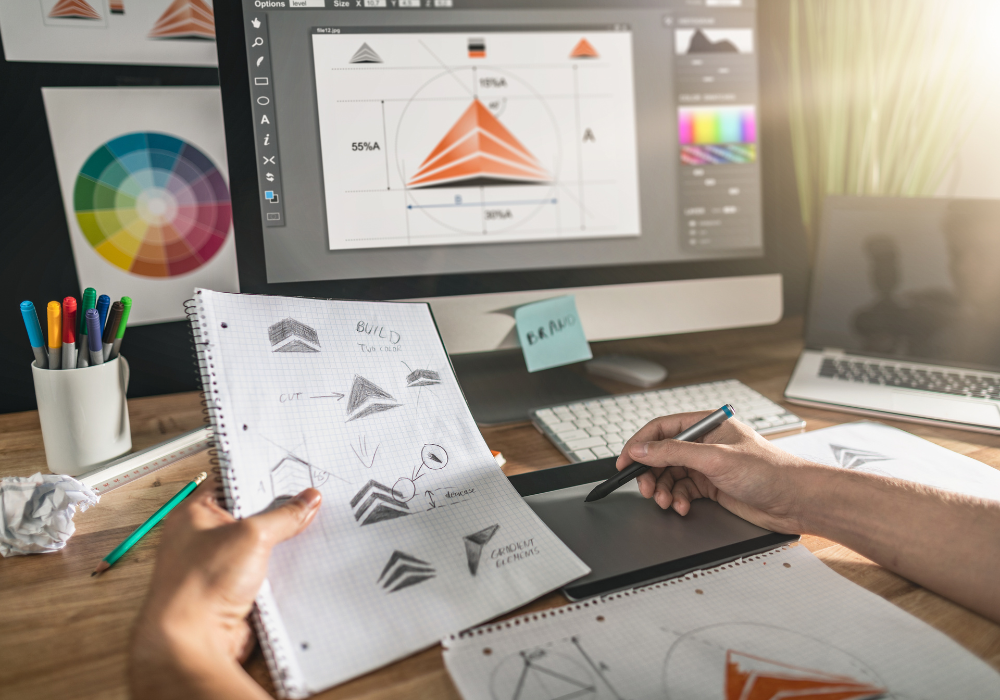A well-designed logo captures your business’s essence in a simple, clear, and memorable way. It’s more than just a symbol or a piece of graphic design—it’s the face of your brand, the first impression you give to potential customers, and an essential element of your company’s identity. In an age where people are bombarded with countless brands and messages daily, having a solid logo is vital to standing out, building trust, and connecting with your audience.
But what exactly does your logo say about your business? And how can you ensure it’s sending the right message? In this blog, we’ll explore how your logo reflects your brand identity and how to craft one that speaks to your audience.
The Role of a Logo in Brand Identity
Your brand identity is the collection of elements—logo, colors, typography, messaging—that create a perception of your brand in customers’ minds. A well-designed logo is the cornerstone of your brand identity, acting as the visual shorthand for everything your company represents.
When someone sees your logo, they should immediately get an initial sense of your company’s personality, values, and the kind of experience they can expect. For instance, a tech startup might want its logo to convey innovation and cutting-edge technology, while a nonprofit may focus on community, compassion, and trust.
A logo’s design can convey various messages, from professionalism and reliability to creativity and fun. Therefore, it’s crucial to ensure that your logo aligns with your brand’s broader values and resonates with your target audience.
The Elements of a Logo: What They Communicate
Each element of a logo—shape, color, typography, and imagery—plays a specific role in how your brand is perceived. Let’s break down these elements to understand what they can convey about your company:
Color
Color is a powerful tool in logo design because it instantly evokes emotions and conveys meaning. Different colors are often associated with feelings and concepts like trust, excitement, or creativity. For example, many financial institutions use blue to communicate reliability, while eco-friendly brands frequently choose green to represent growth and sustainability.
A well-thought-out color scheme should be visually appealing and align with the emotions you want your brand to evoke in your audience. To dive deeper into how color can impact your brand, check out our blog on the psychology of color and how it influences customer behavior.
Shape
Shapes have unique associations, meaning different shapes in your logo can subtly convey critical aspects of your brand identity. For example, circles convey unity, wholeness, and continuity, making them ideal for brands emphasizing inclusivity or global reach. Squares and rectangles, on the other hand, are linked to stability, strength, and professionalism, often chosen by more traditional, established companies. Triangles can be associated with power, innovation, and forward-thinking, so they are commonly seen in tech and engineering logos. More organic or freeform shapes suggest creativity, individuality, and uniqueness, making them popular for artistic or more unconventional brands. Each shape can add a layer of meaning, helping your company’s logo visually communicate the values and characteristics of your business.
Typography
Typography plays a crucial role in logo design, as it helps set the tone and personality of your brand. Since different typography styles convey distinct messages, the font choice in your logo is just as important as colors and shapes.
Serif fonts convey tradition, professionalism, and reliability, making them ideal for brands that emphasize heritage. In contrast, sans-serif fonts provide a modern, clean, and approachable look, often favored by companies seeking a contemporary image. Script fonts add elegance and creativity, lending a personal touch especially popular in luxury, fashion, and beauty. Bold, thick fonts communicate strength, confidence, and authority, projecting a powerful and reliable brand image. Ultimately, your font choice should align with your business’s tone, ensuring the typography complements your overall message.
Imagery and Symbols
Many logos incorporate imagery or symbols that visually reinforce a company’s identity and values. Think of Apple’s iconic logo, a simple apple with a bite taken out of it, symbolizes innovation, simplicity, and cutting-edge design. On the other hand, Nike’s swoosh suggests motion, speed, and dynamism, perfectly aligning with its focus on athleticism and performance.
Imagery in logos can be either literal or abstract. A literal image directly represents the product or service, while an abstract symbol evokes feelings or concepts that resonate with the brand’s ethos. Some logos also use subtle elements that reveal deeper meanings upon closer examination. For example, the FedEx logo features an arrow formed by the negative space between the “E” and “x,” symbolizing speed and precision. Regardless of the approach, a well-chosen image or symbol can make a logo instantly recognizable and help the brand stand out.
How to Create a Logo that Speaks for Your Brand
Designing a logo that communicates your brand identity requires careful thought and planning. Here are a few tips:
Know Your Audience
Before you begin the design process, make sure you have a deep understanding of your target audience. Who are they, and what are their values and preferences? Your logo should resonate with them and reflect what they care about most.
Stay True to Your Brand Values
Your logo should authentically represent your company’s mission, values, and personality. It should feel genuine and consistent with your broader brand identity, from the messaging to the customer experience.
Keep It Simple
The best logos are often simple and easily recognizable. Avoid overcomplicating your design with too many elements. A clean, streamlined logo will make it easier for customers to remember and associate with your brand.
Ensure Versatility
Your logo will appear in many places—on websites, social media, packaging, merchandise, signage, and more. It must be versatile enough to work in different sizes and formats, from large tradeshow banners to small business cards.
Evoke Emotion
Your logo should do more than just look good—it should make your audience feel something. Whether trust, excitement, or curiosity, a successful logo creates an emotional connection with your customers.
Your company’s logo is one of the most powerful tools in your branding arsenal. It’s the visual embodiment of your company and plays a crucial role in shaping how customers perceive your brand. By carefully considering the elements of design, you can create a logo that looks great and conveys the right message and emotions to your audience. A strong logo will help you build recognition, trust, and loyalty, ensuring your brand leaves a lasting impression.
Looking to enhance your brand identity? Reach out to us today to explore how we can design a logo that authentically represents your company.









